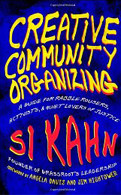
Creative Community Organizing: A Guide for Rabble-Rousers, Activists, and Quiet Lovers of Justice
Si Kahn
240 pages, Berrett- Koehler Publishers, 2010
Si Kahn’s latest book, Creative Community Organizing, is a reflective collection of stories and songs from Kahn’s long and venerable history as a community organizer. He tells riveting tales from his experiences as an organizer with the Student Nonviolent Coordinating Committee (SNCC) in Arkansas in the 1960s, with the Brookside Strike and other campaigns fighting for the rights of mine workers in Kentucky and mill workers throughout the South in the 1970s and 1980s, and, finally, with Grassroots Leadership, an organization he founded that fights for the abolition of for-profit prisons and an end to immigrant family detention.
Kahn’s objective in writing the book is to help interested readers answer a question he often hears: “So do you think I should become an organizer?” By writing the book, he hopes to provide an inspirational, but honest picture of what it means to be an organizer so that idealists can make their own choices about whether this is the path for them. Like any good organizer, Kahn teaches through storytelling. His narrative voice is affable, inspirational, and humorous. The book is strongest when Kahn illustrates some of the complex ethical and strategic challenges organizers face through vivid examples from his own past.
In one of his earliest experiences as a young (Jewish) organizer with SNCC, Kahn describes learning strategizing. To force a white-owned store to hire black cashiers, SNCC leaders decide to boycott only one of four department stores in the city, to prevent the storeowners from uniting together against the black community. “Brilliant!” Kahn thinks. “So which of the department stores were we going to boycott?” When his SNCC mentors respond, “The ‘Jew store,’” Kahn freezes in his tracks. “SNCC was fighting for the ultimate underdog, African-Americans. [I understood the strategy, but] to target another historic underdog, even if one more privileged than his black customers—didn’t that just reinforce the injustice?”
Kahn wisely avoids moralizing in these stories and instead raises questions, describes his own experiences and reactions, and leaves us to ponder the choices we might make ourselves.
In one of these instances, Kahn tells the story of Aunt Molly Jackson, an activist who robbed a store at gunpoint to steal food for impoverished mining families. In raising some of the ethical issues in this story, Kahn asks, “Is Aunt Molly Jackson an organizer or a community leader?” This question raises an important point that unfortunately goes unanswered.
One of the book’s shortcomings is that Kahn never defines what it means to be an organizer, as distinct from a community leader or other type of activist. Too often, the term is used to represent any person doing any kind of community-based advocacy or service work. Organizing is not just any kind of community-based work, however. It is a specific approach to making change that involves, at a minimum, bringing people together to discover common resources they have to fight power structures that marginalize them or their constituents.
An organizer’s emphasis on bringing those without power together to discover and create the collective resources they need to fight those with power implies certain values that underlie organizing. For instance, change comes from within the community. Organizing is not just about solving problems, but also about creating capacity (such as motivation and skills for democratic leadership) within communities to solve problems. Service provision, marketing, and creating policy that “nudges” individual incentives are all alternative approaches to making community-based change that are distinct from organizing because they do not involve building capacity.
Clarifying what organizing is and how it is unique could have grounded some of the 20 principles of organizing Kahn identifies. For instance, he has a forceful discussion about the importance of diversity in organizing, providing concrete strategies for organizers seeking to ensure that they maintain sensitivity to race in building organizations. Yet he falls short in arguing why respecting diversity is so important. Is it just a liberal norm that we must respect? Or is it grounded in the core philosophies of organizing, in identifying and developing leadership within the community to leave it stronger than when the organizer found it?
Organizing is a powerful tool for social change that historically has helped to change the world. We need to do more to sharpen our definitions of what it is and develop widespread understandings of what it can accomplish. Kahn’s book is a valuable contribution to this effort, providing readers with an accessible set of narratives and reflections about life as an organizer. The next step for anyone trying to understand how social change works is to develop more coherent, empirically grounded theories of organizing that can shape the work of the future organizers Kahn is recruiting through his book.

